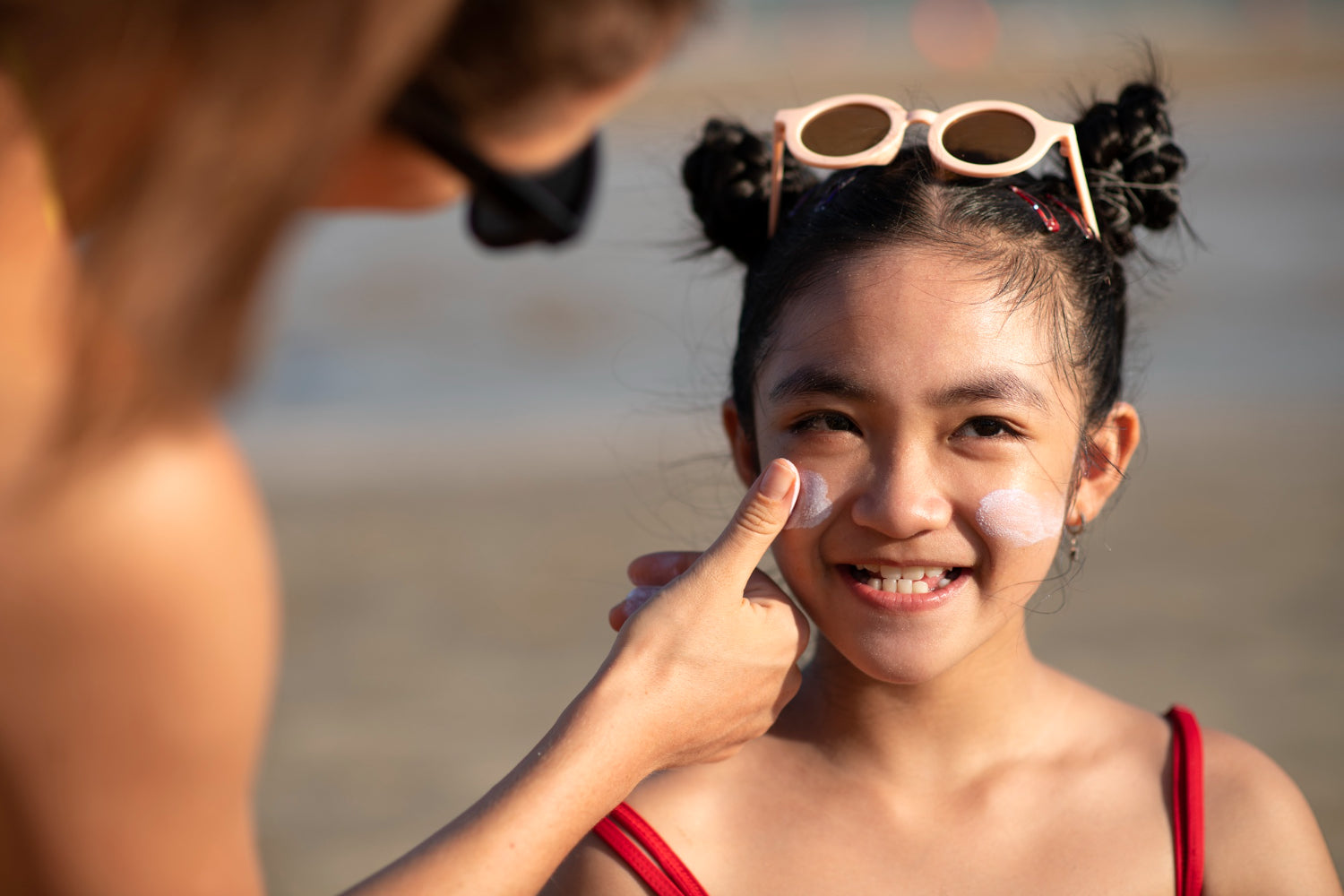
Sun Safety for Kids: How To Protect Your Kids Skin
Sunshine brings out giggles, grass stains, and endless hours of outdoor play but it also brings a hidden threat to your child's delicate skin. That golden glow may look harmless, but ultraviolet (UV) rays can cause damage long before the first signs of sunburn appear.
Kids are natural explorers, often too busy chasing butterflies or building sandcastles to notice the toll the sun is taking. That's where you step in with sunscreen, shade, and a sun-smart game plan. Teaching sun safety early isn't just about preventing a single burn; it's about laying the groundwork for healthy skin for life. Let's know more about sun safety for kids.
Keeping the Kids Safe in the Sun: When to Be Extra Careful
Why is sun safety important? The sun is strongest between 10 AM and 4 PM, particularly during the spring and summer months when UV rays are at their peak. During these hours, kid's skin is more vulnerable to damage, especially if they're playing outdoors without proper protection. Sun safety is therefore important to protect their skin.
While it's important to protect your child year-round, extra precautions are necessary during outdoor activities near reflective surfaces like water, sand, or concrete these can bounce back UV rays and increase the risk of sunburn. Even cloudy days can be deceptive; up to 80% of UV rays still penetrate the clouds.
So whether you're headed to the park, pool, or playground, knowing when and where the sun's rays are most intense is your first step to safe play.
7 Must-Know Sun Safety Facts for Kids
Sun safety for kids isn't just about sunscreen, it's about smart habits and awareness. Every parent should keep these sun safety facts in mind:
-
Kid's skin is more sensitive to UV rays than adults' skin.
-
Just one blistering sunburn in childhood can double the risk of melanoma later in life.
-
UV rays are strongest between 10 AM and 4 PM, even on cloudy days.
-
Shade reduces UV exposure but doesn't eliminate it completely.
-
Clothing with a tight weave or UV protection rating can block harmful rays.
-
Reapplying sunscreen every 2 hours or after swimming/sweating is essential.
-
Most skin damage from sun exposure happens before the age of 18.
-
Sunburns increase the risk of skin cancer.
-
Children under 18 are at higher risk of UV damage.
Tips To Protect Kid's Skin From Sunburn
You might think that sunburn is a temporary irritation, but for kids, it's a sign of serious skin damage. Here are some sun safety tips to protect kids from sunburn:
Dress Smart with Sun-Protective Clothing
Make your kids wear lightweight, long-sleeved shirts, wide-brimmed hats, and sunglasses with UV protection. Look for clothing labelled with UPF (Ultraviolet Protection Factor), which provides an added layer of defence against harmful rays.
Seek Shade Whenever Possible
Encourage kids to play under a tree, umbrella, or canopy during peak sun hours. If you're at the beach or park, setting up a shaded area gives them a cool, safe zone to retreat from direct sunlight.
Limit Outdoor Time During Peak UV Hours
If possible, plan outdoor activities in the early morning or late afternoon. Avoid letting kids stay out too long during midday when the sun's rays are most intense.
Keep Them Hydrated
Sun exposure can quickly lead to dehydration, especially in active children. Offer water frequently, and encourage them to take breaks in the shade to cool off and recharge.
Use Sunscreen Generously
Apply a broad-spectrum sunscreen with SPF 30 or higher to all exposed skin 15–30 minutes before going outside. Don't forget spots like the ears, back of the neck, tops of feet, and behind the knees.
How to Use Sunscreen Safely?
One of the best sun safety tips for your kids is to use the sunscreen to protect their skin. But there is a right way to apply it. Here's how to make sure that the sunscreen gives effective results to your kids:
-
Choose mineral sunscreen for your kids with SPF 30 or higher. Mineral-based products with zinc oxide or titanium dioxide are gentle on sensitive skin.
-
Apply sunscreen 15 to 30 minutes before sun exposure. This allows time for it to form a protective layer.
-
Use a generous amount. A child-sized handful is often required for full-body coverage.
-
Don't miss the easy-to-forget areas. Ears, back of the neck, scalp (if the child has thin or no hair), and feet are commonly missed.
-
Use an eco-friendly sunscreen made with natural ingredients, free from harsh chemicals, mineral oil, sulfates, phthalates and silicones. This is especially important because kid's skin is sensitive, and you can't just use any cosmetic product on it.
-
Reapply every 2 hours. Reapply more often if your child has been swimming or sweating heavily even if the sunscreen is labelled "water-resistant."
-
Use sunscreen even on cloudy days. UV rays can still reach and damage the skin through clouds.
Conclusion
The sun can be your child's best friend or worst enemy but it all depends on how you prepare. Following sun safety for kids helps prevent sunburn today and lets you invest in your child's lifelong skin health.
When it comes to choosing a sunscreen you can trust, Lav Kids SPF 50 Mineral Sunscreen checks all the right boxes. It's -
-
100% mineral-based (with zinc oxide).
-
Free of harsh chemicals and synthetic fragrances.
-
Water-resistant and gentle on sensitive skin.
-
Dermatologist-tested and safe for babies and children.
Whether your little one is off to school, summer camp, or just playing in the backyard, Lav Kids SPF 50 Mineral Sunscreen keeps them protected without compromise. Get in touch with us for more kid-friendly skincare products and keep your child's skin happy, healthy, and safe.
Frequently Asked Questions
1. What's the best way to protect a kid's skin from sunburn?
Use broad-spectrum SPF 50+ sunscreen, dress them in sun-protective clothing, and keep them in the shade during peak sun hours (10 AM to 4 PM).
2. What do I do if my kid gets a sunburn?
Cool the skin with a damp cloth, apply aloe vera or a kid-safe after-sun lotion, and keep them hydrated; consult a doctor if the burn is severe or blistering.
3. How can I protect my kid's skin?
Apply sunscreen regularly, dress them in hats and UV-protective clothing, and limit sun exposure during midday.
4. When are kids most at risk from the sun?
Kids are most at risk between 10 AM and 4 PM, especially during summer and in high UV index areas like beaches or playgrounds.
5. When is the best time to apply sunscreen to kids?
Apply sunscreen 15–30 minutes before sun exposure and reapply every two hours or after swimming or sweating.
6. What are some top tips for applying sunscreen to kids?
Some sun safety tips include - Using a generous amount of sunscreen, not missing ears, neck, and tops of feet, choosing a kid-friendly mineral sunscreen, and making it part of their daily routine.



